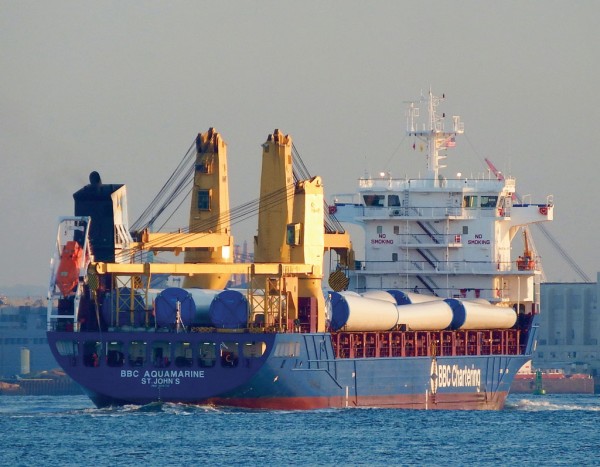The port commission also eyes future, allocating resources to explore logistics hub scenarios.
Thanks to its proximity to manufacturers like GE Energy, in Schenectady, New York, project cargo has been a mainstay for the Port of Albany for some time. In fact, “We call ourselves the premier heavy lift and project port in the northeast,” said Tony Vasil, the business development and marketing manager at the Albany Port District Commission.

New Warehouse and Wharf Reconstruction
A big lift warehouse at the port is currently under construction and should be completed by the end of June of this year. The new, 45,000 square-foot climate controlled facility will have a 2,000-pound per square foot load factor, enabling it to handle heavy cargo from shippers like GE Energy.
The warehouse project is tied in with a wharf reconstruction project on the south end of the Port of Albany. “We anticipate receiving barges of GE products that are too large to move by rail, from a height rather than weight basis,” said Vasil. “They will come down the Mohawk River and through the locks to be offloaded at a new ro/ro slip.” From there, the big pieces will be loaded on 18-wheel articulated trailers, which will move them to the new project cargo warehouse, located at the north end of the port. The roll-on/roll-off ramp is expected to come online in 2019.
Power plant components are becoming larger, noted Bill Ring, general manager Federal Marine Terminal in the Port of Albany, meaning that fewer can move by rail and making ro/ro options critical for a port like Albany that specializes in project cargo. “It’s easier to handle project cargo when it can roll on and off,” he said. “The ro/ro slip will also avoid the costs of some of the heavier barge cranes. There is a definite interest in this kind of expansion throughout the project industry.”
The facility is not for GE’s exclusive use, however, and Vasil noted that the port, and FMT, specifically, have handled project cargo from many other companies, including Siemens, Bechtel, Ericsson, Babcock & Wilcox, and others. “In the last year and half, many coal-fired electric plants in the northeast have been phased out and older gas plants are being refurbished,” he said, “so we are seeing a good amount of cargo related to those projects.”
These improvements are going to benefit the operations of FMT, which handles much of the project cargo traffic at the port. “The new warehouse was originally built for GE’s use,” said Ring. “This will give GE the opportunity to store generators and turbines at the port. If they are produced ahead of schedule, the new warehouse will give them a local option for storage so we will get the work when it comes time for exporting.” Without the new facility, GE would ship its components for storage to another port with the required capabilities in advance of shipping.
FMT Lease
In November of last year, the Albany Port District Commission signed a new 10-year agreement with FMT to provide longshore and other cargo handling services at the port. FMT has provided those services at the port for over 10 years. The new contract, with three five-year renewal options, means FMT could operate in Albany for another quarter century.
In 2017, the Port of Albany handled components for steam generation plants in Lordstown, Ohio, and Wilkes-Barre, Pennsylvania. Vasil expects that this year, similar work will come through for the port for a plant near Poughkeepsie, New York. These kinds of projects are massive, noted Ring, with total volume for each, to include generators, turbines, and other components, reaching tens of thousands of cubic meters.
Cargill, Incorporated, the massive food and agricultural products company headquartered in Minneapolis, was one of the initial companies to operate at the Port of Albany when it opened in 1932. However, in recent years, the Fortune 500 company has decided to funnel their export product form the Midwest through ports on the US gulf and west coasts, to the detriment of Albany.
“We used to handle a quarter of a million tons a year for Cargill,” said Vasil.
Ardent Mills, which is owned in part by Cargill, and is based in Denver, will be taking over the lease on the Cargill facility. Instead of using the facility for exporting, it will be receiving imports from places like Turkey, Egypt, Argentina, and Brazil. The facility will become active under the aegis of its new operator “within a couple of years,” according to Vasil.
Another project at the port will see an existing old warehouse, referred to as Shed Number One, which is not cost-effective to refurbish, torn down to be replaced by a new structure. The port received some funding for that project from the US Maritime Administration.
Ring expects more import project cargo this year and next through the Port of Albany to make up for a shortfall in exports seen since the beginning of this year. He has also seen upticks in the handling of scrap and wood pulp and expects some inbound wind energy projects this year and into 2019.
No question, the port will continue to focus on heavy lift and project cargo. “We’re always looking for that type of opportunity,” said Vasil, “and we have an excellent reputation in that area.”
Meanwhile the port commission is looking to expand the port’s horizons. Its 2018 budget includes resources to retain firms for engineering and consulting work “on possible expansion opportunities.” Some of that activity could include land acquisition, through which the port “could position itself to meet warehousing/distribution facility/logistics hub demand.”





